I have eight hydrangeas in the garden, a modest enough number but given their relatively large size in my small garden, enough. I rate them highly as ornamental plants, producing a fine display of bloom for a couple of months in June and July.
Not one is a typical mop headed Hydrangea macrophylla, not because I have anything against them but they are very common and I have only to look out the window to see two large bushes covered in flowers in someone else’s garden. It appeals to me to have something different. A number of less commonly encountered varieties have come my way and filled the space, so that’s what I have.
In nursery days it was always the case that some plants were on the way up while others were on the way down. It could be very frustrating if a trend happened very quickly and we either couldn’t produce stuff quickly enough to satisfy demand or conversely, were left with a big surplus when demand for something went over a cliff.
Hydrangeas started to become more popular in the first decade of the 2000’s if I recall correctly, with interest building quite steadily and being sustained for a good few years. That was quite unusual and it gave us the opportunity to develop a really interesting range. The majority of the hydrangeas that we sold were bought in as young plants in 9cm pots and grown on for a season usually in 3L pots.
Almost all these liners came from New Place Nurseries in Sussex or Pépinières Minier, in France. As specialist propagators they picked up on the increasing interest in Hydrangeas and started developing their own ranges and I tried to be adventurous with getting new varieties, even though they were an unknown for us as growers and the same for customers. Provided they could be brought into flower, selling them was rarely a problem.
Another wholesaler that we dealt with was a local nursery that grew a wide range of unusual plants, a good deal of it under contract to a well known retail nursery up country. He would from time to time have a few extras which he would put on his availability list in very small numbers, sometimes only one. That suited me just fine, usually wholesalers want you to buy in multiples of five or ten and if you only want one because you intend to propagate it yourself, you don’t get the option. That was the source of three of the varieties I still have.
The typical garden hydrangea is Hydrangea macrophylla. I have two forms of it with much in common but very different in character. Both are of Japanese origin, both are double flowered. One, ‘Izu-no-hana’ was collected in the wild, the other, ‘You and Me Together’ is the product of a modern breeding program.
‘Izu-no-hana’ is quite large growing and produces lace-cap flowers with a single row of double sterile flowers around the central grouping of fertile flowers. It flowers freely but nowhere near densely enough to mask the foliage. The effect is refined, light and airy, especially for a macrophylla variety.

The You and Me series were raised in Japan by R. Irie. They combine double flowers, flowering on current season’s growth, repeat flowering and a compact habit. They claim you can prune them to 10 cm in February and get flowers from midsummer until winter. I haven’t pruned my young bush that hard but it has carried on producing flowers deep into autumn and they stay in good condition for months. It would be very hard to beat for flower power but its compactness and the amount of flower costs it a little in elegance. Flowering on new growth means it will probably be fine in frost pocket gardens where the autumn produced buds get killed and probably means its size is relatively controllable. I moved it last year to replace H. serrata ‘Tiara’, which had struggled for the last few years because of being in too sunny and dry a position.
Hydrangea ‘Garden House Glory’ is a hybrid between H. macrophylla and H. serrata that was selected at The Garden House in Buckland Monochorum. The foliage has red tints when new and can colour well in autumn. The flowers are lacecap and a vibrant pinkish red, seemingly on both acid and alkaline soils. My plant has spent most of its life much too close to a very large bamboo and hopefully will perform better in its new, more congenial location, formerly occupied by H. ‘You and Me Together’.
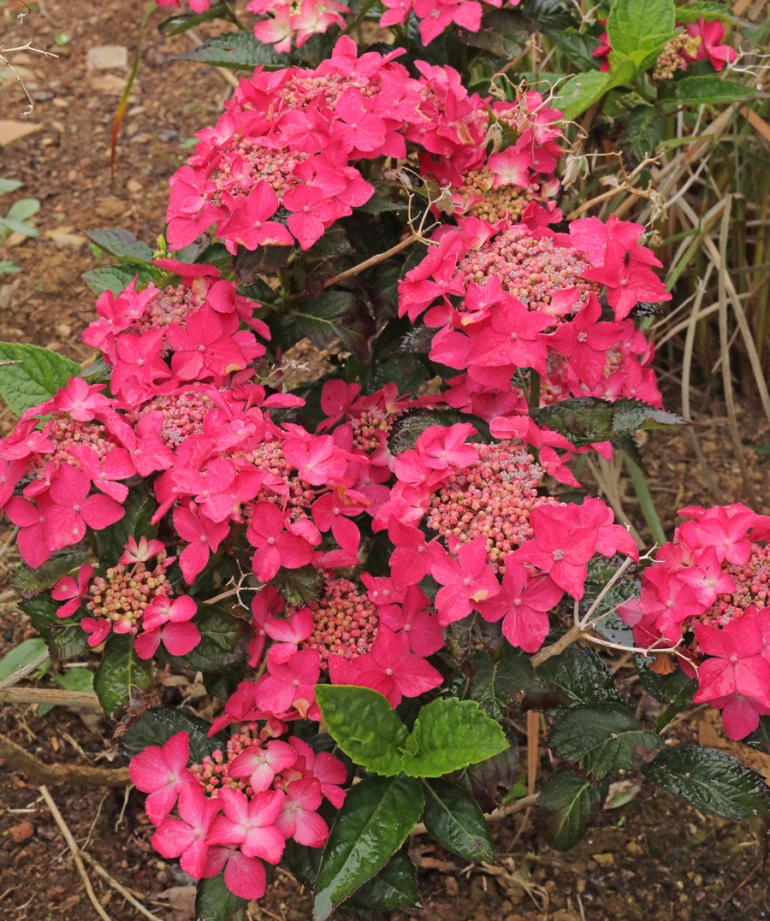
The aforementioned trio from the local wholesaler are all serratas. Hydrangea serrata is a Japanese woodland species of smaller stature than H. macrophylla with smaller, thinner leaves. Two of mine are of Japanese origin, ‘Shojo’ and ‘ ‘Fuji-no-taki’.
‘Shojo’ gets quite large, mine is now around five feet tall and wide. It took a very long time, 5 or 6 years, to start to flower freely but now produces masses of medium sized lacecaps, the sterile florets on which start out pale blue fading to near white at the centre, deepening to cobalt blue before gradually turning purple. They are set off by a background of very dark foliage, nearly black in some light conditions, but due to dark red pigmentation of the leaves.
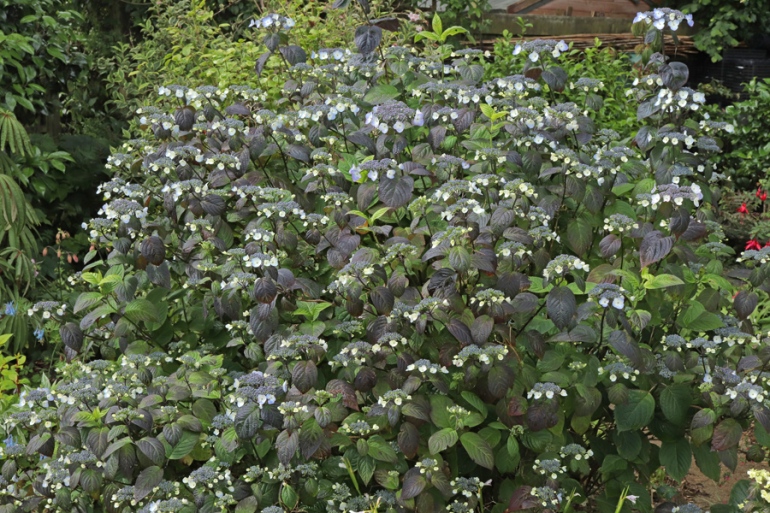


‘Fuji-no-taki’ makes a small bush to a maximum of a metre, though mine is still only half that after a dozen or more years. It becomes completely covered in dense heads of double white flowers which almost completely hide the few fertile florets which technically make it a lacecap variety. The sterile florets start pure white with a greenish yellow centre, then gradually turn pink from the outer petals inwards. Close up photos reveal blemishes that you don’t otherwise notice.
The serrata trio is completed by a variety raised in Brittany, France, called ‘Cap Sizun’. It is a lacecap but with enough sterile florets to be approaching a mophead in effect. In my garden it flowers a beautiful, clear light blue, gradually turning a little toward purple as it ages. The petals are frilly edged, adding to its charm. At its peak of flowering very little foliage is visible. Like ‘Shojo’, in the last two or three years the foliage has acquired very dark tints, contrasting with the pale flowers.

My remaining two hydrangeas are paniculatas, which is to say they are varieties of the species Hydrangea paniculata. This is another species which caught the attention of plant breeders sometime in the 1990’s or thereabouts. Before then there had been around five unspectacular varieties available but new ones started appearing at the rate of 4 or 5 a year. Go to the Plant Finder section of the RHS website and a list of 161 varieties comes up, albeit including many that appear to be unavailable.
I have ‘Early Sensation’ which doesn’t do what the RHS description says it should, it is neither early nor is it a sensation. It did colour well one autumn but that’s not a reliable attribute in Cornwall. It’s nice enough but knowing that many much better forms are available I am very tempted to upgrade.

The other one was a reject from the rejects. Put onto the cheap bench then pulled out to be thrown away because it was still there months later. It had one weak stem about 30 inches tall. I planted it in next door’s front garden and took the tip off. It produced a few shoots and the following winter I cut them back hard. After a few seasons it had quite a nice head on top of a three foot stem and when the neighbour died I rescued it and relocated it to our back garden. It’s a great way to grow them, with space beneath for other things above which it displays its own flowers. It gets cut back to the main framework each winter. This is a great attribute in a small garden as the size is controllable without losing flowers.
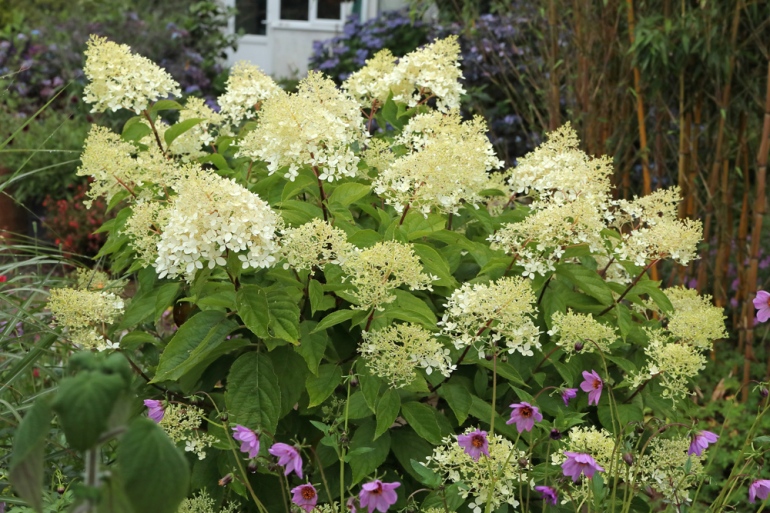
I should give an honorary mention to H. serrata ‘Tiara’, aka plus one. It was in the bed beside ‘Cap Sizun’ and peforming beautifully. Then I cut down the Magnolia that was shading it through the middle of the day and it went downhill fast, wilting badly on every sunny day. Though just beside it, ‘Cap Sizun’ still gets shade from other trees and is fine. I took some cuttings, dug up the bush and gave it away to a garden in Liskeard where it is much happier. The cuttings are now nice little plants in 2L pots and if a suitable space was available I would plant one this afternoon. ‘Tiara’ was a Maurice Foster selection, to which the appropriate response is “Ah, Maurice; say no more”. When in the garden it flowered a similar shade of blue to ‘Cap Sizun’ but in a pot it is flowering pink. The aluminium that is available to turn the flowers blue in my garden is simply not there in a soilless compost, no matter how acid it may be.

As with much in life, you pays yer money and you takes yer choice. The macrophyllas are tough and accommodating, they will perform well under a wide range of conditions. Most of the others are a little more fussy, though not excessively so, but they are less well known and less frequently on offer in nurseries. If something different appeals to you, but you still want something of high ornamental value, they are worth looking into. You’ll have to search for obscure varieties and the RHS Plantfinder online will be a help. You could do a lot worse than to start with Pan-Global Plants. I’ve been there, I’ve spoken to Nick Macer but he wouldn’t know me from Adam and I certainly won’t get anything for the plug.

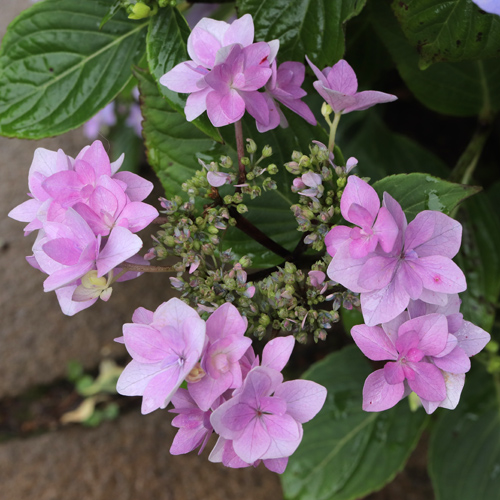



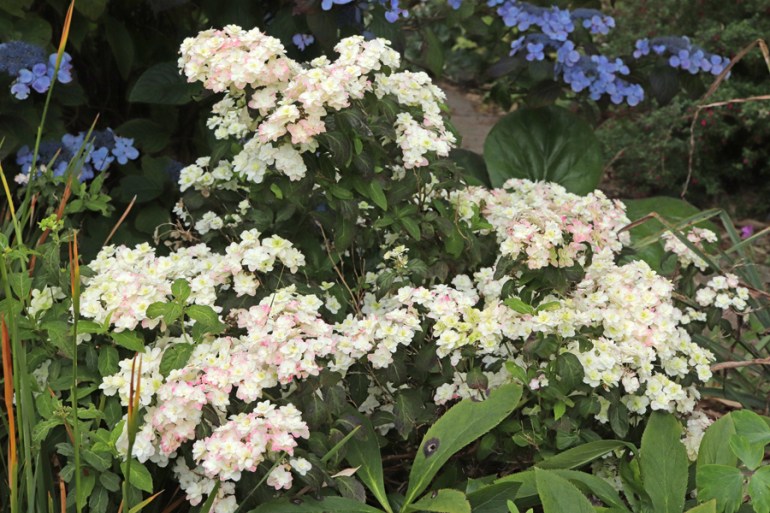
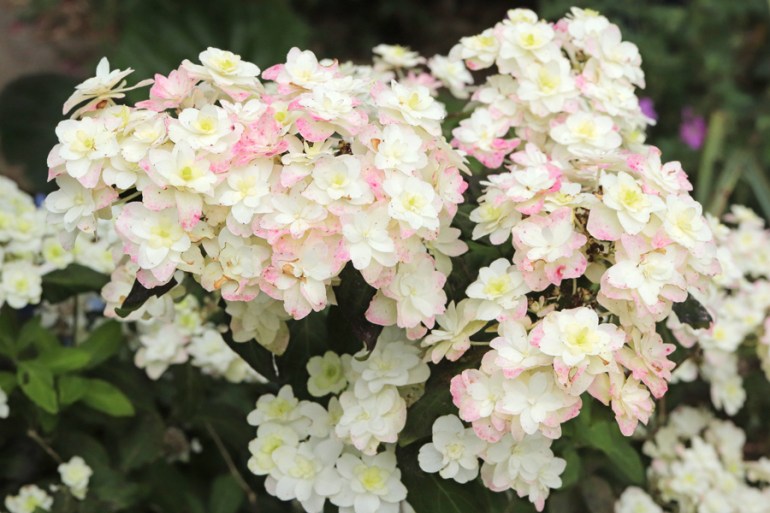
Thanks, Jim! I’m going to try again next season. 🙂
LikeLike
Good to hear!
LikeLiked by 1 person
Thanks for this informative article, Jim. My mom loved hydrangeas – they lived in Paarl Valley in the Western Cape South Africa – fairly Mediterranean type climate with hot summers and wet and cold winters. Yet, their hydrangeas were enormous and gorgeous. Me, on the other hand, living here in Lancashire where a friend of mine described the rain as “wet rain” has not had much success. I’ve recently lost two plants and I just don’t have place indoors. Nevertheless, I loved your photographs and interesting article. Happy writing and cultivating for the rest of this week. 🙂
LikeLike
We’re familiar with “wet rain” in Cornwall, though it’s not quite so cold as Lancashire. It’s so often the case that when something struggles, you never really know why. I’m pleased you enjoyed mine though.
LikeLiked by 1 person
Thanks Jim, We have a hot day now, but according to the weather report that is about it for the next few days. I’m going to try hydrangeas again, but I’ll have to get them going indoors first. 🙂
LikeLike
Good luck, I hope they thrive for you.
LikeLiked by 1 person
Those really are nice. I still prefer the old fashioned mop heads. We did not grow any though. There was not enough demand for them. The newer cultivars were trendy here too.
LikeLike
Wikipedia has a partial list of Hydrangea species, four of which are from USA. You’d maybe expect that a genus split between America and Asia would turn up in the west of the US but all four; arborescens, quercifolia, cinerea and radiata, are from the east. I’m curious about how American gardens regard the native and alien species. Do people favour the natives, even though they may be somewhat unsuitable in their region? Or are they overlooked as garden plants because they’re native?
LikeLiked by 1 person
There are two extremes, with not much in between. Most people do not care, but just want their garden to look good with whatever survives in it. Those who want natives are fanatic about it. However, some believe that plants that are native to all parts of California are considered to be native. California has more diversity of climate and ecosystems than many other states combined. What does well in the Sierra Nevada or the Mojave Desert does not necessarily do well here. Regional natives are actually quite limited, and not very appealing. My favorite palm happens to be from the Mojave Desert, so does not do well at all near the coast or in irrigated landscapes. In this region, the landscapes are dominated by the massive redwoods, whether we like them or not.
LikeLike
Most of our native plants would be fairly happy anywhere in the UK, this being a small and fairly homogenous island. Very different from the US.
LikeLiked by 1 person
It is particularly different in California. Between here and town, just about fifteen miles away, there are more climate zones than in the entire state of Oklahoma, and probably Kansas too. That is why the entertainment industry got established in Niles and then relocated to Hollywood.
LikeLike
Has that left California with a particularly rich wild flora or is that not how it works? Probably not given that the tropics are the most species rich areas and have fairly even climates.
LikeLiked by 1 person
The flora here is remarkably diverse. Chaparral species inhabit the Santa Clara Valley, but the redwood forests are just a few miles away. Alpine species inhabit the Sierra Nevada. Desert species inhabit the Mojave Desert. The tropic also have diverse ecology because of the diverse geology, sort of like California, but with a bit more uniformity to the climate. Ecosystems of coastal plains are very different from those of mountains.
LikeLike
Interesting stuff. A lifetime with plants and I still know almost nothing.
LikeLiked by 1 person
Almost nothing? There is too much to know. You may not a whole lot more than nothing, even it if it minimal relative to what there is to know.
LikeLike
Too much to know, too little time and way too little memory.
LikeLiked by 1 person
An interesting and informative post from you as always. Regarding the Hydrangea paniculata – I have a young Vanille Fraise which struggled to get going this spring, but has done eventually with nice growth but no flowers. How hard do you recommend I cut it back and when? With my bog standard mophead I leave until spring before cutting off the flower heads back to a good pair of buds and removing any dead or crossover stems.
LikeLike
You prune Hydrangea paniculata much like Buddleja. The lower part will form a permanent framework and the top part gets removed and regrows each year. You can keep the permanent part very low, 6-12 inches from the ground, or you can let the bush grow up a bit then prune to create a higher framework. My short standard started with a single stem about 3 feet tall and I removed just a few inches from the tip, cutting just above a pair of buds. The topmost pair of buds and probably the next pair down, grew out and made 12-18 inch shoots which flowered on the tips. In the winter those shoots were cut back to leave a single pair of buds at the base of the shoot. All but around an inch of the shoot produced that year is removed. In the spring the two buds grow out and the cycle is repeated. The lowest pair of buds may be right at the base of the shoot or an inch or two up it; if they’re right at the bottom you might choose to prune to the next pair up. In all likelihood only one pair will grow.
I could have cut the original single stem lower down and had a shorter main stem, or no main stem at all. I could have allowed only one shoot to develop from the top, trained it up another couple of feet and made a taller standard.
Funnily enough, while I was writing the hydrangea article Sue was out at a garden centre and came back with H. paniculata ‘Vanille Fraise’. It’s around four feet tall with eight stems, all with a flower head at the top. I shall report on what gets done to it for the next year or two. It’s likely to go in the middle of a bed and be pruned initially to about 18 inches, but we may change our minds.
LikeLiked by 1 person
Thanks for this Jim. Mine is very low growing at the moment. I shall cut the shoots back carefully in the winter to a single pair of buds on each stem and see how it gets on next year. It did have flowers last year but was in a container and very floppy so I removed it and cut it right back to the main stem.
LikeLiked by 1 person
I was interested in your comment on aluminium in the soil.I have a neutral soil and wondered what would happen to a blue lacecap such as your Japanese ones. No clues in the gardens locally, they are mostly acid.Can you recommend any reading on ph and hydrangeas please.
LikeLike
https://www.americanscientist.org/article/curious-chemistry-guides-hydrangea-colors will tell you far more than you want to know. It was posted as a link by https://sweetgumandpines.wordpress.com/ in a six a few weeks back.
LikeLike
That’s a fabulous selection; all beautiful and worth a place in the garden. Some of our older plant, H. macrophylla cultivars, are struggling in the last few years with a lot of die-back, good regrowth and further die-back. I’m not sure what to do with them – dump and replace with something newer for variation or try to rescue them. Any advice?
LikeLike
If they’ve made good regrowth it seems unlikely that they have honey fungus or root rot. If they were here I’d say the most likely cause of problems is spells of drought causing damage to the roots. When rain comes they appear to recover in that a compromised root system can take up enough water for a plant in cooler damper weather but when the next dry spell comes they get found out. If that is the problem then anything that helps retain water or reduce water loss should help. If young plants do better it’s often because if appropriately spaced their root systems have a much greater volume of soil to draw water from, at least to begin with.
LikeLiked by 1 person
That makes such perfect sense and pertinent to what we are seeing here. I think it is a case of a very good watering and a very generous mulch. Many thanks, Jim.
LikeLiked by 1 person
Lovely lot there Jim. Interesting to hear some of the history too. I just have three standard mopheads, which I enjoyed growing from cuttings. Maybe one ought to be moved on to make room for something a little different. I wonder whether a rooted cutting of ‘You and Me’ may come my way via your propagation bench?
LikeLike
I should think that’s very possible. I will get on it tomorrow.
LikeLike
You are a gem, Jim. If you fancy a Pelargonium coriandrifolium, some nice plants are coming on.
LikeLike
I’d love the Pelargonium. The hydrangeas don’t have roots showing yet but look perky.
LikeLike